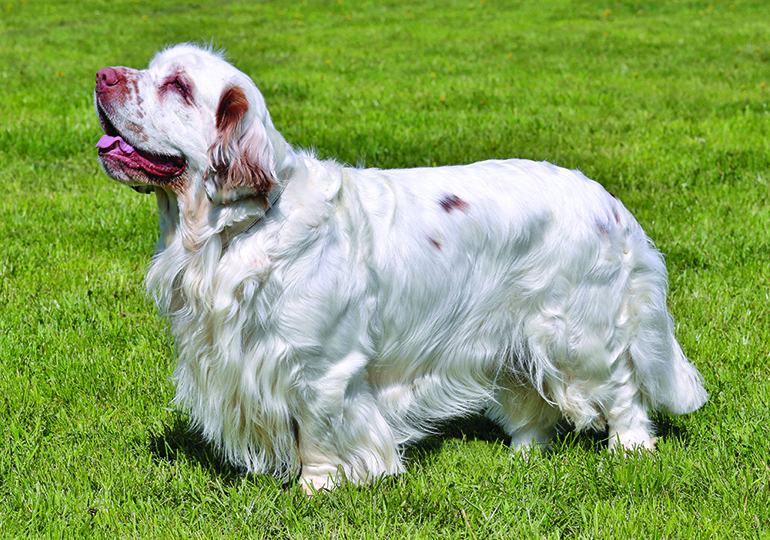
GROUP 3 - GUNDOGS
The Clumber Spaniel is named after the Duke of Newcastle's Nottingham country estate, Clumber Park, and the breed was once owned by British royalty; firstly by Prince Albert, consort of Queen Victoria, then his son King Edward VII who bred them in his Sandringham kennels. Edward's son, King George V, a sportsman and hunter continued the Clumber tradition.
It has been claimed that the Clumber Spaniel has both the Basset Hound and the now extinct Alpine Spaniel in its ancestry. This most distinctive flushing Spaniel has retained more Hound genes than other Spaniels with a long, heavy but not very tall body and a heavy head. The Clumber is bred for hunting in heavy cover where its largely white coat makes it easy to see. The breed's strong build ensures it is able to penetrate dense undergrowth to flush or retrieve game. This breed possesses great stamina, is a silent worker with an excellent nose and will not tire from a long day of work.
The Clumber Spaniel is not overly active, but makes for a friendly, sociable and calm companion. It is also gentle, loyal and affectionate, but dignified and may be aloof with strangers.
The Clumber is a well balanced, heavily boned but active dog with a thoughtful expression. The breed's overall appearance denotes strength and its coat is lemon/ white or orange/white - the more white the better. The Clumber has no height standard but its weight should be between 15.5 and 29kg.
Canine hip dysplasia can be an issue in this breed and because of the requirement to 'show haw' any tendency towards entropion and ectropion (turning inward or outward of the lower eyelid) must be rigorously monitored and eliminated.
Clumbers can be expected to live between 11-12 years of age, but with correct nutrition and an optimum environment will live to 15 years. However, sufficient exercise is needed if the Cl umber Spaniel is to avoid gaining weight.
Clumber Spaniels have a generally low maintenan<:e, thick, soft weather-resistant coat. To keep the coat free from shedding, hair brushing and combing should be done on a regular basis.
The breed's eyes and ears should be regularly checked. Trimming the feet, the feathering under the ear hole, from the wrist to the foot on the front legs and from the hock to foot on the hind legs every two months should be sufficient.
As a hunting Gundog, the Clumber is happiest in a pack or kennel situation with a canine (preferably Clumber) friend for company. The breed usually adapts well to other non-dominant breeds, but can be just as content in a single dog family. It does not take kindly to rigorous, repetitive training, but rather prefers to assimilate what is happening around it to learn through observation.
Words: Dianne Fenton
Image: Shutterstock.com
Now you know a little about the Clumber Spaniel, you may think that this is the dog for you. Before you make a decision, please make contact with the breed club or your State controlling body for purebred dogs. They will be able to give you information about available puppies and also suggest dog shows where you can see the breed and speak to breeders. In this way you will gain a better perspective of the Clumber Spaniel and its needs, and whether this breed would suit your lifestyle.